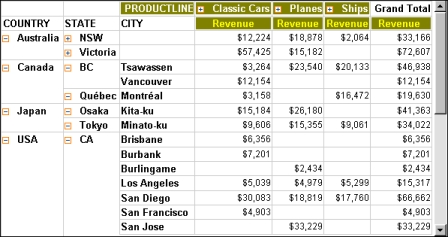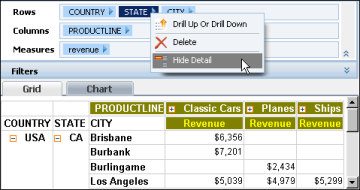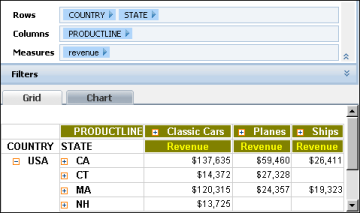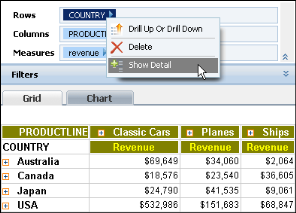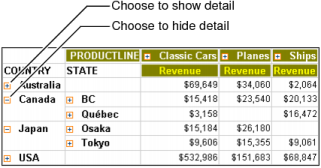Typically, a cross tab displays data in a hierarchy. For example, a cross tab might display data by country, state, and city, or by year, quarter, month, and day. Data Analyzer supports drilling up to display higher-level, summary data, or drilling down to display lower-level, detail data. Hiding details, particularly for a cross tab that runs into hundreds of pages, helps you display key information at a glance. The following illustrations show two cross tabs that contain the same data. In Figure 3-38, the cross tab displays the revenue-detail data for cities.
In Figure 3-39, the cross tab hides the details, showing revenue-summary data for each country.
You can hide details to reduce the size of a cross tab. Alternatively, a BIRT iHub System administrator can change the value of the MAX_PAGE_SIZE parameter in web.xml to display a larger cross tab. For more information about modifying web.xml, see Information Console Developer Guide.
|
|
In the structure pane, if more than one hierarchy level appears in Columns or Rows, you can hide the detail values for a level. For example, Figure 3-40 displays country, state, and city levels in Columns. To hide details in the level below state, in the structure pane, right-click State, and choose Hide Detail, as shown in Figure 3-40.
|
|
Figure 3-40
|
In Figure 3-41, the structure pane and cross tab show country and state levels and hide the city level.
|
Figure 3-41
|
|
|
|
Figure 3-42
|
The cross tab and the structure pane display detail levels, as shown in Figure 3-43. The cross tab expands the hierarchy levels under Country. This cross tab does not display the countries details for Canada and USA, which the user did not select to appear using the Drill Up Or Drill Down dialog box.
|
Figure 3-43
|
|
|
|
Figure 3-44
|
|
|
You can select from a list in which levels to show details and in which levels to hide details. How to display detail and summary data describes making multiple selections.
|
